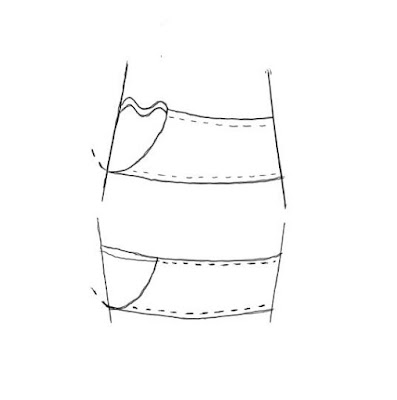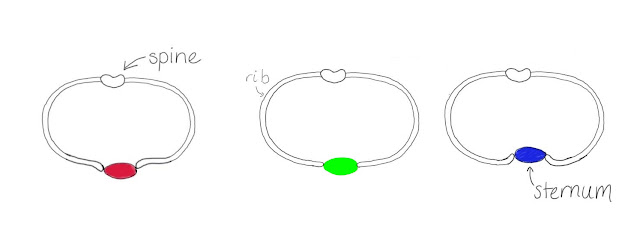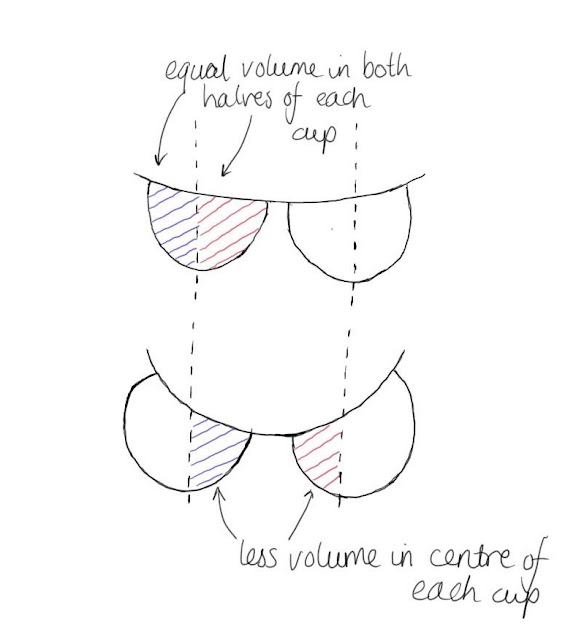Rib Cages and Bra Fitting - a Masterpost
I've realised that while there are titbits (pun intended) of information about how rib Cages can affect bra fit floating around, it's never been collated into one easy to access article. So I've tried to do that: most of the information in this post is credited to other hardworking bloggers, please check out the credits at the end to support their work! Also big thanks to my sister for the lovely diagrams.
1. Rib Cage Shapes (horizontally)
There are two basic types of rib cross-sections to consider in relation to bra fitting, disregarding the sternum (we'll get onto the breastbone later):
 |
| Flat vs Barrel Shaped Ribs |
- Flat ribs (left) - the most common rib cage shape
- Barrel shaped ribs (right) - more rounded than the average rib cage shape
Most bras are designed to fit best on flat ribs.
If you have barrel shaped ribs, the cups of a bra may tilt outwards, meaning that you need more depth in the centre than fullness tests suggest. Wires may dig in at any point (the gore, the bottom or the sides) as the wires are bent more than the manufacturers expect.
If you experience these issues, softer wires can help as they more readily move to suit the rib cage, or you can bend the wires to a curve to suit your rib cage shape better. Check the resources for information on bending the wires.
2. Rib Cage Shapes (vertically)
Vertically speaking, there are three basic types of torso:
- The straight up and down or tube shaped torso
- The A shaped torso (which is narrower at the top and wider at the bottom)
- The V shaped torso (which is wider at the top and narrower at the bottom).
Most bras are cut for straight up and down or V shaped torsos.
Because of this, if you have an A shaped or tube shaped torso, you may experience issues with band tension - bras tend to dig in at the bottom of the band only, which can be uncomfortable (due to the weight of the breasts being distributed over a smaller area) and/or cause some fit issues in the cups.
 |
| A shaped at the top, V shaped at the bottom |
When the band only fits at the bottom, and the top of it is loose, the wires aren't tensioned properly. Wires in bras are designed to be flexed a little when worn, so if the wires aren't flexed at the top, the bra can be unstable and there may be empty space in the upper/outer quadrant of the cup.
People with V shaped rib cages may find that traditional methods of measuring cup size overestimate cup volume, as all differences between bust and underbust measurement are considered to be breast tissue.
People with any rib cage shape may find themselves hooking bands unevenly to make the tension even again, though this only tends to happen with pronounced V or A shaped rib cages or pronounced V or A shaped bras.
3. Rib flares
Rib flares are small sections of ribs which stick out further than the rest.
They can occur anywhere on the rib cage and can cause quite a lot of pain when wearing bras.
Issues with pain and rib flares mostly occur if they exist in the area where the wires or band sit. This is because the wires or band can put a lot of pressure on the ribs, which are quite sensitive.
If the flare exists under the wires, positioning the wires a bit lower or buying bras with different wire lengths/widths can help avoid the issue of pressure on the flared ribs.
Softer wires can also flex with the rib cage more so may help to reduce pain associated with rib flares.
Bending the wires around the pressure points so they follow the shape of the rib cage better can also help with pain.
If the flare exists under where the band sits, try different band widths and elastic thicknesses.
4. Pectus Excavatum, Pectus Carinatum
 |
| Left to Right: Pectus Carinatum, a "normal" sternum, and Pectus Excavatum |
Pectus Excavatum can mean that gores (or all heights or just certain heights) don't tack, instead just floating in between the breasts, and that the wires can dig in painfully on the front of the rib cage.
To reduce these issues, you can bend wires around your rib cage, use padding under the gore , and/or experiment with gore heights, to reduce pain or increase the likelihood of getting a gore to tack.
Pectus Carinatum can mean that gores may dig in painfully. It may also cause similar issues to those caused by barrel-shaped rib cages.
Bending wires outwards at gore, and experimenting with gore heights can help reduce any pain.
5. Scoliosis
Scoliosis is a medical condition where the spine has a noticeable curve in it.
This may mean that your breasts are functionally at different heights - which means it will be hard for the cups to sit in your inframammary fold on both sides, and may cause issues where the top of a cup cuts into one of your breasts for being too short, but the other cup fits well.
You can remedy these by adding a filling in the bottom of the cup on your higher breast if it bothers you, and/or trying bras with stretch lace to accommodate the different heights.
People with scoliosis may find that one strap slips down, as one of their shoulders is lower than the other.
You can remedy this by tightening the strap that slips down, or potentially using a racerback clip to anchor the straps in place. However, some people find racerback clips to be uncomfortable on their spine and shoulders.
People with scoliosis also are more likely to have rib flares and dips, so check out the other sections in this post, as well as breast asymmetry which I won't go into in this post, but you can find more info about here.
You could also try wider bands for increased comfort and less pressure on the spine.
6. Torso composition
Torso composition is pretty simple. You can have more or less fat, and more or less muscle, on top of your bones. These can intersect - a person can have lots of fat and lots of muscle, or little fat and little muscle, or any combination.
Generally speaking, the more fat a person has on their torso, the snugger they prefer their bands to be. This is because fat is compressible, so a smaller band is needed to keep the band at a good tension to support the bust and stay secure. If you have more fat on your torso, you also are more likely to experience bands sliding, flipping, or rolling up. You can experiment with band widths and presence of boning in the band to try to remedy this.
People with muscular torsos or with little of either fat or muscle often prefer looser bands, as muscles are not very compressible, and bone definitely isn't! Small bands can be uncomfortable for these people, and larger bands often provide the correct amount of support as well as comfort.
Furthermore, flesh distribution can affect rib cage shape. For instance, your bones may form a straight up and down shape, but you may have muscles that cause your rib cage to be effectively V shaped, or may have fat that makes your rib cage effectively A shaped, or any number of things.
7. Breathing
If you play a wind instrument, sing, do lots of intensive sports, or generally have a rib cage that expands a lot when breathing, you may wish to wear a stretchier band. A stretchier band will be snugly fitting when at a neutral breath, and will yield more easily to a full breath in.
If you liked this post, be sure to follow me for updates!
Resources/Bibliography:
Barrel chest /horizontal rib cage shapes:
Fashion Incubator - A Question of Thoracic Shaping
/r/ABraThatFits - "Can we talk about rib cage shapes?"
V shaped rib cages:
Bratabase - V Shaped Ribcage
Band tension:
Wide Curves - It's not the bra style, it's your bra band tension!
Wide Curves - Update on Altering Bra Band Tension for a Better Fit
Bending wires:
Bras I Hate & Love - What to do with those Pesky Wide Underwires
Pectus Excavatum:
Venusian Glow - Bra Fitting and Pectus Excavatus (sic)
Bratabase - Bra fitting with pectus excavatum
/r/ABraThatFits - Pectus Excavatum
Barrel shaped & V shaped rib cage (called funnel shaped here):
Brastic Measures - Fit Issue: The Funnel-Shaped Rib Cage
Rib flares:
Wide Curves - Ribcage Flares and Bra Band Fit
Scoliosis:
Venusian Glow - Choosing Well-Fitting Bras for Scoliosis {Reader Question}
/r/ABraThatFits - I just need help with bras, scoliosis and life
Torso composition:
Katherine Hamilton - How Body Composition Affects Bra Fit






Interesting article!
ReplyDeleteI have particularly awkward rib shaping that I just can't figure out - it doesn't quite seem to match any of the descriptions exactly. My ribs have a sort of vertical flare which when I had smaller breasts looked like a second pointier, bonier set of boobs! It almost looks like this from a top down cross section -v-v-
and means that there is an incredibly tiny space under my breasts for a wire & band to sit. Meanwhile the sides and back are more V shaped, it just the very front of my ribs under my bust which seem A shaped.
I always have to bend the wires to fit my weird ribcage shape and have issues with bands flipping up if deep due to the glaring in front. The wire will stay put but the elastic will fold up as there is just not enough vertical space! Basically I have to go for styles where the bottom of the underwire is the bottom of the band. Which is hard for my bust size! I did used to play flute growing up which probably made my natural issues even worse!
I know this is old, but what you are describing is almost certainly pectus excavatum. The rib flare you describe is common for women. Depending on the exact shape, fitting a bra can be a nightmare.
DeleteI have this problem as well. Bras hurt! I am 56 and still trying to find something comfortable that doesn't shift up.
ReplyDeleteThis is great. Where do I find these special bras
ReplyDeleteI gave up on bras as a teenager. I have flared ribs under each boob. This means the band of any bra bunches up, no matter how narrow. If I feel like I need to wear a bra, I wear a body shaping camisole that I took the wire out of.
ReplyDeleteTHANK YOU! I have a barrel-shaped ribcage and a rib flare in the front. I measure at a 32F, but 32Fs are consistently -- across brands and bra types -- very painful for me! I always end up in a 34 which by many fit standards is too loose, but it's the only size band that isn't painful. Ha! I so appreciate you providing terminology to help me express this issue.
ReplyDeleteHad breast reduction years ago. No sagging, won’t lift and concave on top. Help
ReplyDeleteThis was informative but not super helpful, I have scoliosis, pectus excavatum, and my ribs flare outward under my breasts. I’ve tried hundreds of bras and I fear I will never find a perfect fit.
ReplyDeleteThis is so informative and helps explain why I've always felt like I couldn't find a good bra. And can't wear a chest-strap heart rate monitor either! I always thought I was deformed somehow. To know it's kind of common is sort of a relief.
ReplyDelete